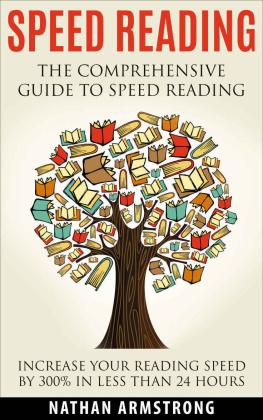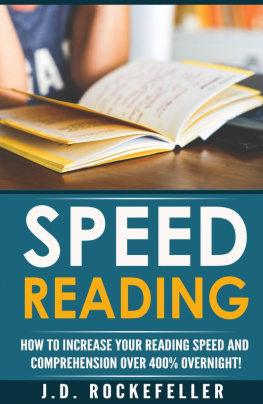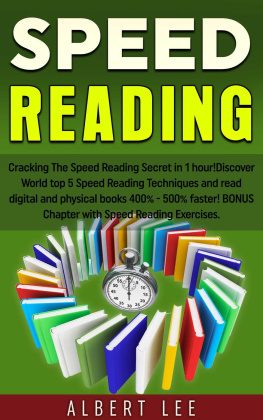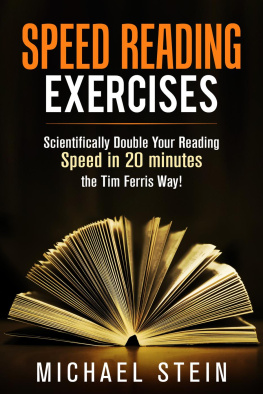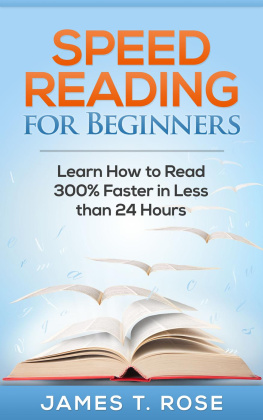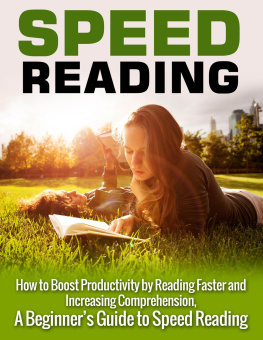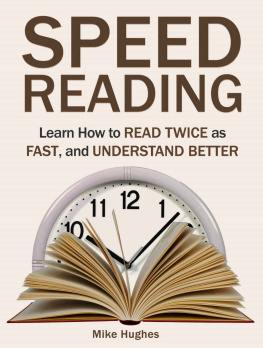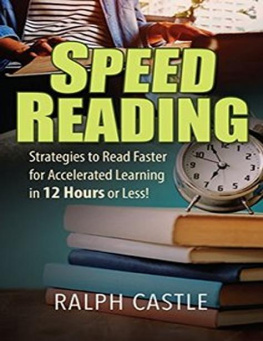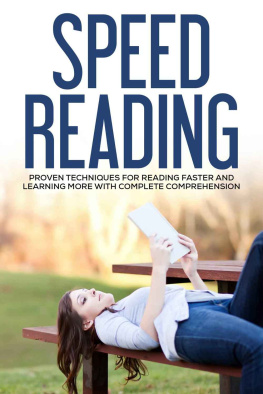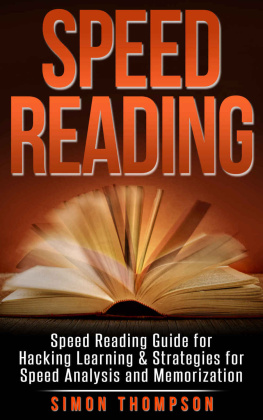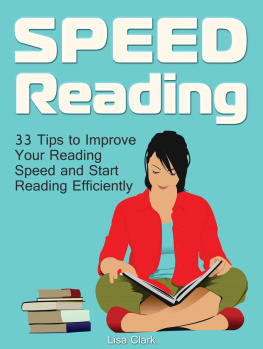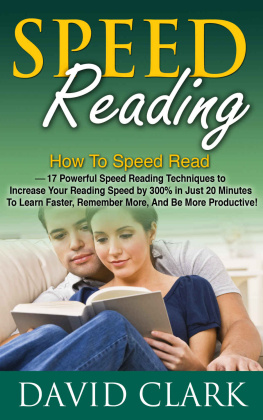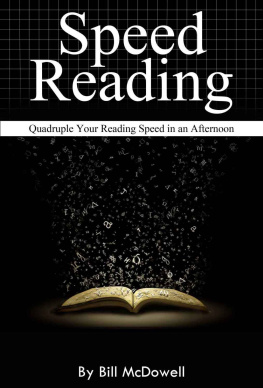Speed-reading
The Comprehensive Guide To Speed-reading Increase Your Reading Speed By 300% In Less Than 24 Hours
Copyright 2015 All rights reserved.
This document is geared towards providing exact and reliable information in regards to the topic and issue covered. The publication is sold with the idea that the publisher is not required to render accounting, officially permitted, or otherwise, qualified services. If advice is necessary, legal or professional, a practiced individual in the profession should be ordered.
- From a Declaration of Principles which was accepted and approved equally by a Committee of the American Bar Association and a Committee of Publishers and Associations.
In no way is it legal to reproduce, duplicate, or transmit any part of this document in either electronic means or in printed format. Recording of this publication is strictly prohibited and any storage of this document is not allowed unless with written permission from the publisher. All rights reserved.
The information provided herein is stated to be truthful and consistent, in that any liability, in terms of inattention or otherwise, by any usage or abuse of any policies, processes, or directions contained within is the solitary and utter responsibility of the recipient reader. Under no circumstances will any legal responsibility or blame be held against the publisher for any reparation, damages, or monetary loss due to the information herein, either directly or indirectly.
Respective authors own all copyrights not held by the publisher.
The information herein is offered for informational purposes solely, and is universal as so. The presentation of the information is without contract or any type of guarantee assurance.
The trademarks that are used are without any consent, and the publication of the trademark is without permission or backing by the trademark owner. All trademarks and brands within this book are for clarifying purposes only and are the owned by the owners themselves, not affiliated with this document.
TABLE OF CONTENTS
INTRODUCTION
I t has been said that haste makes waste. If you consider the popularity of Aesops The Hare And The Tortoise fable, youd quickly get the impression that doing things fast isnt wise but thats not necessarily the case.
In todays day and age, productivity is the holy grail of just about everything from personal activities to business ones. But what is productivity? It simply means getting as much things done as best as they can be done and as quickly as they can be done. In fact, given 2 activities or processes of equal quality, the one thats faster wins the competition hands down.
What lends credibility to the earlier saying and the fable is speed for speeds sake and at the cost of quality. Indeed, haste can indeed make waste when quality is sacrificed. Speed with quality, however, is a very valuable commodity.
When it comes to reading, speed is of utmost importance. Your ability to read and comprehend rapidly can spell the difference between good grades and excellent ones, between a mediocre self-published book to a best-selling one and between a so-so business presentation to one that commands a standing ovation, among many other important things. This e-book is about helping you read much faster than you do now.
In Chapter 1, youll gain a better appreciation for the art of reading as well as for speed-reading, when to use speed-reading and the common obstacles to it. In Chapter 2, youll learn to prepare well before learning to read fast so that youll be able to master speed-reading. In Chapter 3, youll find out the best speed-reading techniques and in Chapter 4, youll learn the best exercises to help you make the techniques as natural as breathing. Next, youll continue off to learn how to supplement these techniques with non-reading approaches such as optimizing your environment for speed-reading, getting enough quality sleep, eating the right foods, getting enough right exercise, using meditation to enhance your ability to focus well, and more!
If youre ready to learn speed-reading, turn the page and lets go.
C H A P T E R 1
SPEED-READING 101
S urviving and thriving as a professional today demands two new approaches to the written word. First, it requires a new approach to orchestrating information, by skillfully choosing what to read and what to ignore. Second, it requires a new approach to integrating information, by reading faster and with greater comprehension. Jimmy Calano
Success requires wisdom, which is the effective application of knowledge. We cant be wise if we dont know. Our ability to gain knowledge of important and relevant things is key to becoming wise. Its like making a delicious cake. Even if we have the ingredients on hand, we cant make it if we dont know how to make it.
Information Overload
Never before has there been a time where knowledge is as easy to access as it is now. With the rapid development of the Internet, knowledge has become both such a precious commodity and a very abundant one. With such abundance, however, come issues with accuracy. As the Internet has made it easy for anyone whos adept at browsing the web to become an expert, sifting the knowledge wheat from shaft has become excruciatingly more challenging.
Thats not an excuse for failure, however. Its simply a great challenge to be able to cover as much material as possible, understand them well and make informed decisions on such materials. Its not a challenge that, quite honestly, we can choose to ignore or decline unless we dont want to succeed in our current fields of education or occupation.
Speed-reading is the one of the best approach to successfully take on this challenge. Of all the important free resources available to us, time is the most limited. Rich, poor, educated, illiterate, healthy or unhealthyall of us only have 24 hours everyday, which makes doing things fast all the more important. To the extent we can read fast is the extent we can cover more reading materials and information. This allows us to be able to sift more chaff from the knowledge wheat and in the process, get more wheat.
Common Obstacles To Speed-Reading
Just like accelerating on a bike or a car, its important to have little or no obstacles that can break or prevent momentum build up when it comes to speed-reading.
From the time that we learnt to read for the first time, we developed many habits that are still with us. These habits are what cause us to read slowly and spend an eternity finishing up a single book.
Consider these three to be your speed-reading bumps that youll need to avoid:
- Word Fixation: When we read, our eyes normally stop on each word. We call this fixation. Stopping at every word in the text that were reading slows down our reading and to a great extent, affect our ability to understand the text well. Why? In terms of speed, consider a 500-word text, with each fixation lasting 1 second. If we stop to read every word, itll take us 500 seconds or roughly 8 minutes to finish the text. In contrast, if our eyes stop to read words in bunches of say, 3 per fixation, then well be able to read the 500-word text in less than 3 minutes. The fewer the fixations or stops, the faster we can read.
In terms of comprehension, more fixations can mean slower or less understanding of the text. Why? Ideas are made up of words and not a single word only. As such, ideas are best understood within the context of a group of words. Take for a basic example the words, I, am, very, handsome and yeah. Isnt it easier to just read, I am very handsome, yeah! instead of individually as a word?
- Retreating: By this, we mean to say looking back or retracing what we have just read unnecessarily or excessively. Sure, there are quite a few moments when we need to go back to what we just read, especially if its quite technical or difficult to understand but if we do it for just about all that we read in a text, itll greatly slow down our ability to read and comprehend the materials on hand.
Next page
